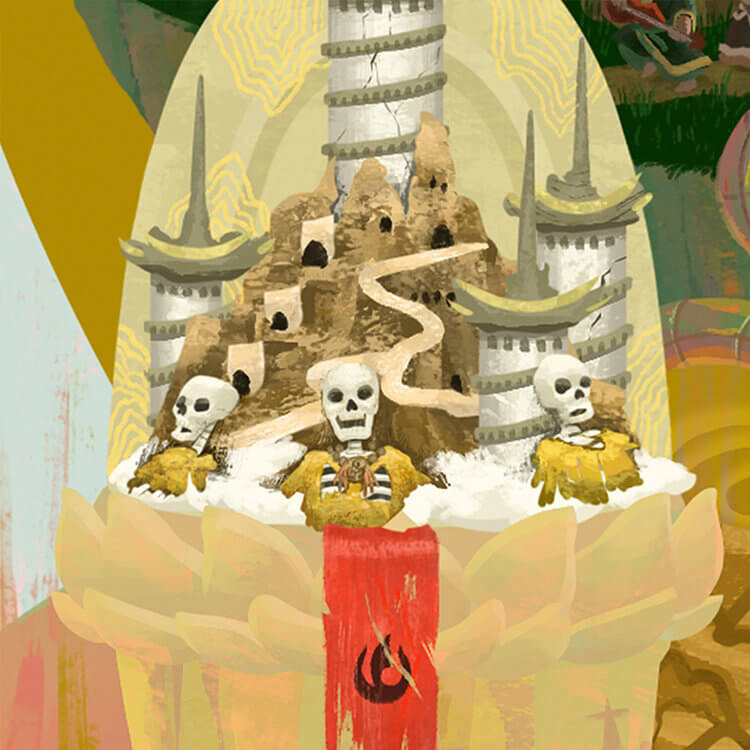AVATAR: THE LAST AIRBENDER
Based on the 2005 American animated series Avatar: The Last Airbender created by Michael DiMartino and Bryan Konietzko, ATLA tells the story of a young monk named Aang, who flees his newfound duties of becoming the next Avatar only to awaken 100 years later to a war torn world. This piece highlights some of the more important story concepts while embellishing some of the stylistic choices presented in the original series.
Explore the details of ATLA
through behind-the-scenes close-ups:
Book 1:WATER
This piece starts at the bottom with Sokka and Katara. It goes up chronologically from Book 1: Water, Book 2: Earth, to Book 3: Fire, simulating the way the 3 seasons of ATLA was categorized. Each of the scenes in each section reflect the events that happened in their respective season.
FUN FACT: If you look closely at the golden seal underneath Sokka and Katara, the seal is actually Aang trapped inside the iceberg with Appa behind him. Having the seal beneath them symbolizes the iceberg being underwater.
THE 4 NATIONS
From bottom to top you will find the Water Nation tribes, Air Nomad Temples, Earth Kingdoms, and Fire Nation. Some notable places are Roku’s Island, Kiyoshi Island, Ba Sing Se, Northern and Southern Water Tribes, Serpent’s Pass, Omashu, The Swamp, and the Si Wong Desert.
FUN FACT: Important scenes are paired with where they happened geographically, including small details such as showing the areas the Fire nation took over (represented by their flag).
SYMBOLISM
There are the more obvious symbols like Sozin’s Comet or the separation of the Four Elements, but also more subtle references like separation of the Day of the Black Sun into 7 phases to represent the 7 stages of Chakra needed to reach the Avatar State.
FUN FACT: Arguably the saddest moment in season 2 is Appa’s lost days, so here Appa is shown with his back to the audience to represent him being lost but flying back towards the gang. If you look closely within the walls of Ba Sing Se, you will also find some posters of Appa flying around.
BENDER VS NON-BENDERS
In the world of Avatar, not everyone can bend the elements. To represent this, certain Benders are shown with multiple arms to illustrate their more-than human abilities, while Non-Benders are shown with two arms. Non- bending never stopped Mei and Ty Lee from kicking butt though!
TEAM AVATAR
Each of the members are shown in their respective element except for Sokka, who’s standing in for Air as a substitute because sarcasm doesn’t count as one of the four elements (It should though). Water, Fire, Earth, Sarcasm. It works.
PREVIOUS AVATARS
The four main Avatars Kuruk, Kiyoshi, Roku, and Yangchen in their spiritual form symbolizing Aang’s connection with his former selves. The other Avatars are either fading into the distance representing his spiritual disconnect or being summoned in for extra strength depending how you want to look at it.
FIRELORD OZAI
Obsessed with power, Ozai’s plan to use Sozin’s comet to take over the other nations doesn’t come without cost: if you look close you can see his hands melting from the heat of the comet and the floor being littered with his soldiers’ helmets.
CABBAGE MAN
Bless his soul. Keep on selling them cabbages.
Scavenger Hunt:
There are so many other little moments and easter eggs in this art piece. If you have time, here are some fun things to look out for:
The White Lotus Pai Sho piece under Iroh
Iroh holding a picture of his late son
The Blue Spirit riding an ostrich horse
Zuko’s mom Ursa
Aang inside the Koizilla controlling it
Princess Yue inside the moon
Aang and kids flying at the Northern Air Temple
Knowledge seekers holding scrolls and books in their mouths
Guru Pathik’s banana-onion juice
a cloud trail of Aang’s face at the Northern Air Temple
June and her Shirshu
Fire Nation Blimps
Avatar Medalions
The two last living Dragons


